Physical Address
304 North Cardinal St.
Dorchester Center, MA 02124
Neonatal skin matures with gestational age with increasing thickness, less permeability, and higher density of sweat and sebaceous glands. Keratinization begins at 24 weeks and matures near term.
Cold stress is an important risk to preterm infants. Lower skin thickness, less subcutaneous fat, and immaturity of the nervous system predisposes to heat loss.
Several minor congenital anomalies may predominantly involve the skin; these include dimpling, periauricular sinuses, pits, tags, cysts, supernumerary digits, supernumerary nipples, umbilical granulomas, and umbilical polyps.
Neonatal intensive care may leave skin lesions such as surgical scars, chemical and thermal burns, and scars from arterial catheters and repeated heal-sticks. Exposure to various infections and drugs may cause erythema multiforme, erythema nodosum, urticaria, and vasculitis.
Several congenital disorders of skin structure may be seen in newborn infants, such as epidermolysis bullosa, aplasia cutis congenita, mastocytosis, incontinentia pigmenti, nevi/birthmarks, and vascular anomalies.
Inflammatory disorders seen in the neonatal skin include diaper dermatitis, allergic contact dermatitis, seborrheic dermatitis, neonatal psoriasis, Langerhans cell histiocytosis, and benign cephalic histiocytosis.
Scaling abnormalities seen in the newborn skin include those seen in collodion babies and various forms of ichthyosis. Ichthyotic changes can also be seen as a part of many complex multisystem syndromes.
Transient cutaneous eruptions seen in neonates range from transient vascular phenomena, benign pustular dermatoses, erythema toxicum neonatorum, transient neonatal pustular melanosis, acropustulosis of infancy, eosinophilic pustular folliculitis, benign pustular dermatoses, sebaceous gland hyperplasia, miliaria, milia, infantile acne, subcutaneous fat necrosis, and neonatal lupus erythematosus to annular erythema of infancy.
Cutaneous infections in neonates include candidiasis, syphilis, herpes simplex, congenital and neonatal varicella, impetigo and staphylococcal scalded-skin syndrome, and scabies.
Several cutaneous neoplasms can be seen in neonates. These include infantile hemangiomas, hamartomatous nevi, epidermal nevi, sebaceous nevi, smooth muscle and pilar hamartomas, connective tissue nevi, congenital melanocytic nevi, giant congenital pigmented nevi, juvenile xanthogranulomas, dermoid cysts, recurrent infantile digital fibromas, congenital or infantile myofibromatosis, and in some cases, malignant tumors.
Newborn skin differs from that of adults in several ways. The following sections summarize developmental changes, transient cutaneous changes seen in neonates and young infants, congenital disorders of skin structure, inflammatory disorders, scaling abnormalities, skin infections, and cutaneous neoplasms. The information is summarized from our own clinical experience and from information mined from PubMed, Embase, and Scopus.
Neonatal skin matures with gestational age in terms of increasing thickness, reduced permeability, and the density of sweat and sebaceous glands. At 30 weeks of gestational age, the skin thickness of about 27.4 μm is only half that of adults. There are fewer intercellular attachments, resulting in higher permeability and transepidermal water losses, and also a higher risk of blistering upon exposure to heat or chemical irritants. Percutaneous absorption of toxic substances is higher. Keratinization begins at 24 weeks and matures near term. An overview of the structure of the neonatal skin is shown in Fig. 102.1 .
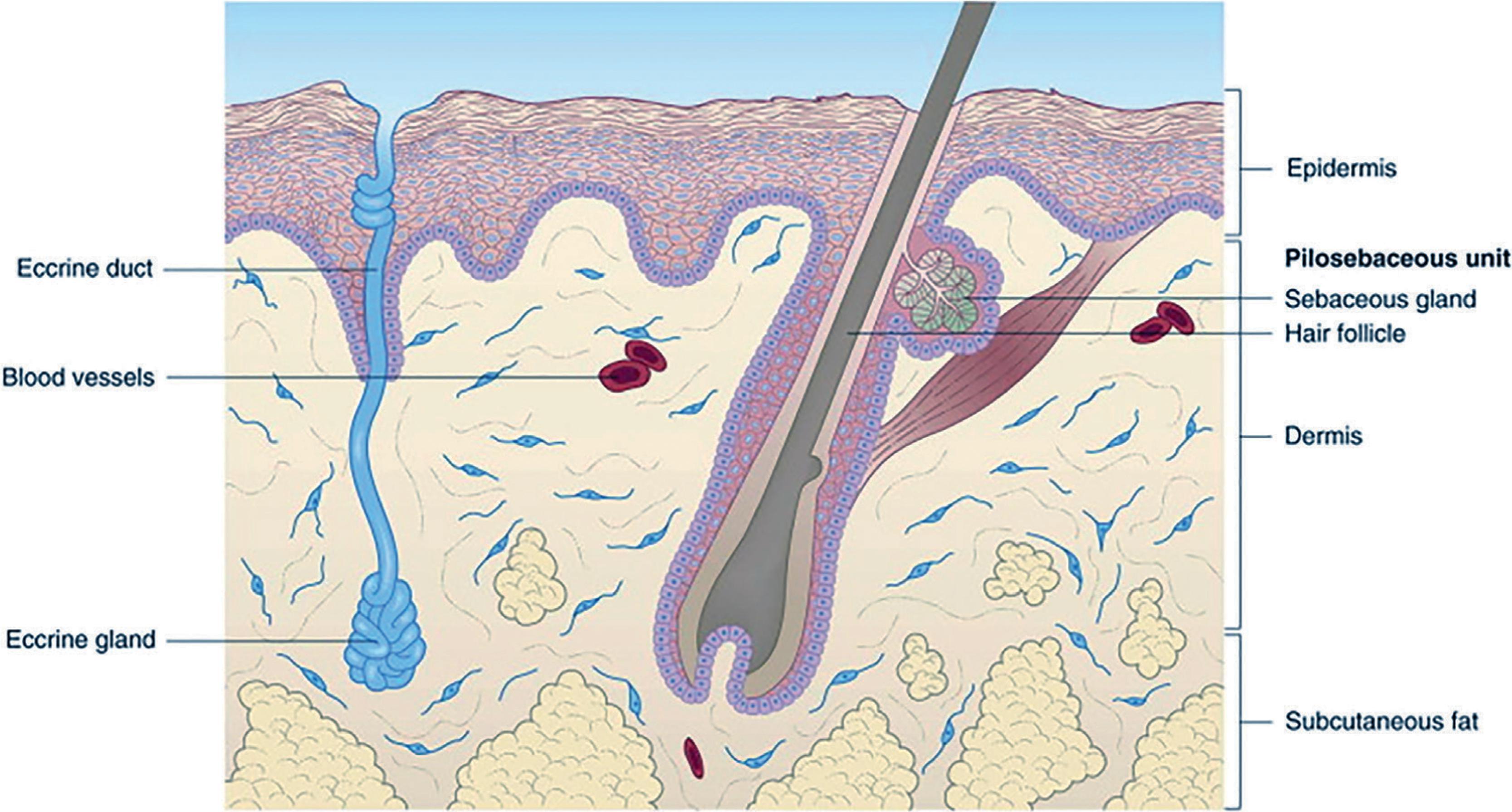
At birth, the skin is covered with vernix caseosa , a greasy white material of pH 6.7 to 7.4 containing lipids, protein, lanugo hair, shed skin cells, and water ( Fig. 102.2A ). Beneath the vernix, the skin has a pH of 5.5 to 6.0. Overwashing, particularly with harsh soaps, may result in irritation and damage the normal barrier function. Some scaling may be normally seen on the trunk and on the hands and feet during the neonatal period ( Fig. 102.2B ).

Newborn infants frequently show many benign, transient skin findings that may be a source of parental anxiety. Early recognition is important to enable appropriate counseling to parents.
Unique physiologic changes such as the Harlequin change are seen in approximately 10% of newborn infants between 2 to 5 days after birth. There is a benign, transient red color change lasting 30 seconds to 20 minutes in half of the body demarcated at the midline ( Fig. 102.3 ).
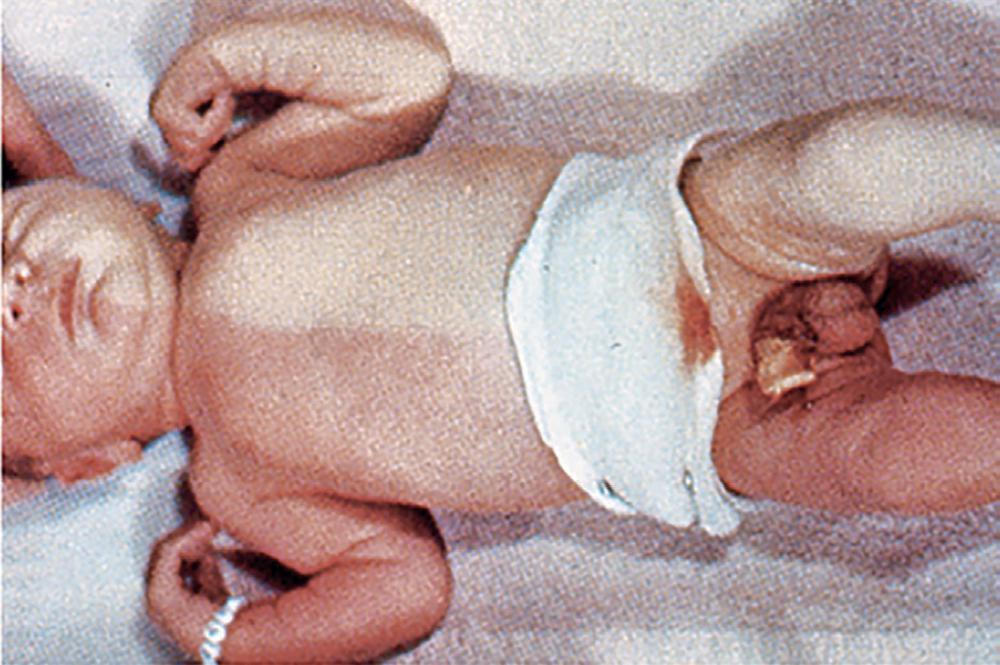
Cold stress is an important risk to preterm infants. Thinner skin layers, less subcutaneous fat, and immaturity of the nervous system predispose to increased heat losses from evaporation, radiation, and conduction. When exposed to cold temperatures, some infants show acrocyanosis with bluish discoloration of hands and feet. There is no edema or other cutaneous changes. Careful examination can help differentiate it from central cyanosis seen on the lips, face, and/or trunk in pulmonary or cardiac disease.
Many infants show cutis marmorata after hypothermia; it is a diffuse, reticulated erythema with bluish-red marbling of the skin on the trunk and extremities ( Fig. 102.4A ). The changes of cutis marmorata may persist beyond the neonatal period in infants with trisomy 18 or 21, Cornelia de Lange syndrome, hypothyroidism, or some central nervous system disorders. These changes need careful differentiation from cutis marmorata telangiectatica congenita or congenital phlebectasia ( Fig. 102.4B ). These latter two conditions may be localized to patches on the trunk or extremities or extend in a Blaschkoid pattern (lines of Blaschko are pathways of epidermal cell migration and proliferation during the development of the fetus).
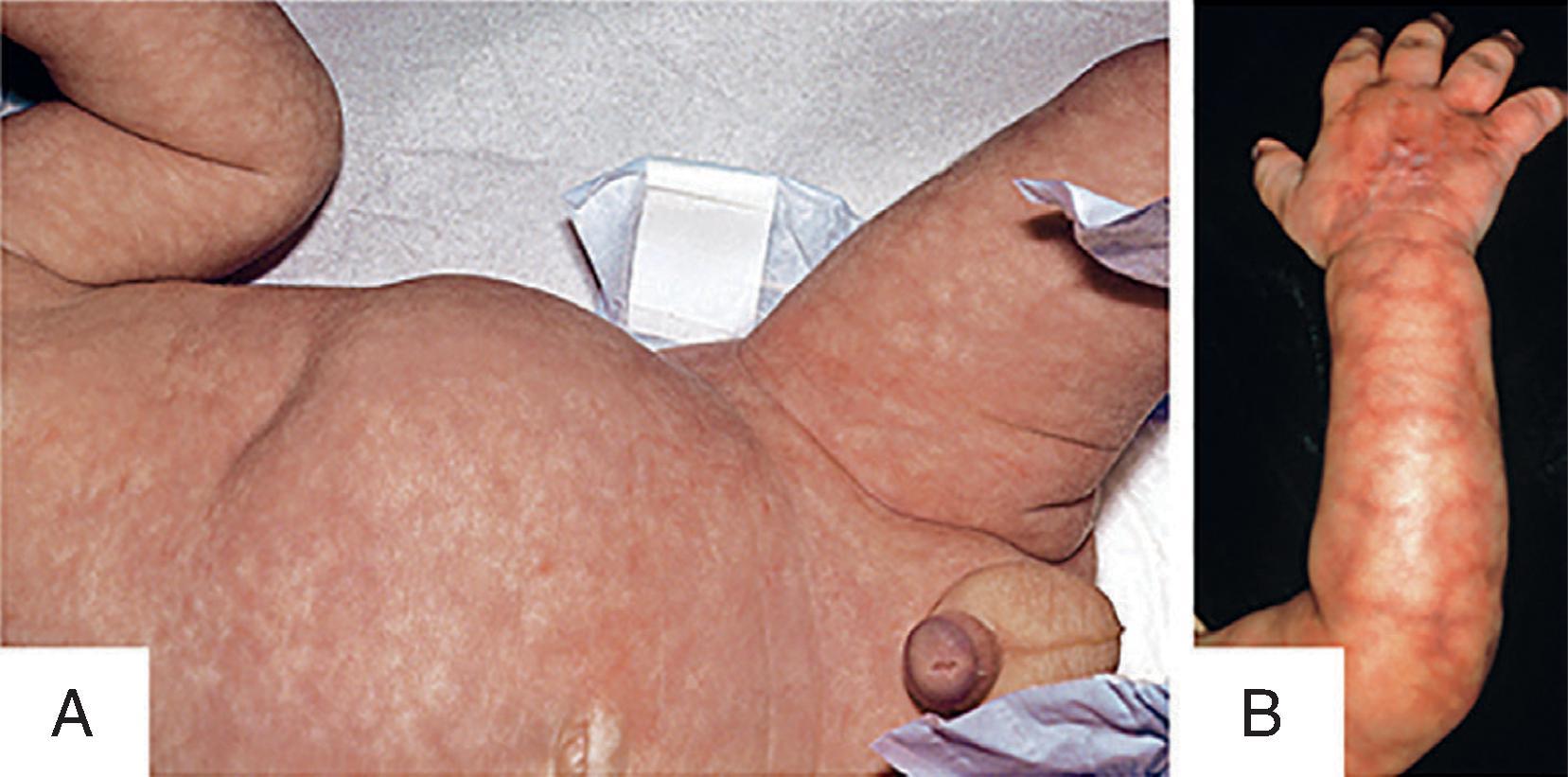
Hyperthermia can also be a problem in growing infants with insulated clothing. Sweat glands may appear anatomically well-formed at 28 weeks’ gestation, but the functional maturity is attained only beyond the first month after birth. Older phototherapy units increased the risk of hyperthermia, although this problem has been resolved with light-emitting diode lights.
Photosensitivity: Melanocytes begin synthesizing and transferring pigment to epidermal keratinocytes by 20 to 24 weeks’ gestation, but the skin surface tends to be less pigmented during the first few postnatal months. Consequently, neonates and young infants have less natural protection from sunlight and are more likely to develop sunburn. Sun avoidance and protective clothing can be effective barriers to excessive sun exposure.
Some disorders increase the risk of sunburns in infants. Hereditary porphyrias ( Fig. 102.5A ), xeroderma pigmentosum, Bloom syndrome, and Cockayne syndrome may increase photosensitivity. Neonatal lupus erythematosus ( Fig. 102.5B ) can also increase the risk of skin rashes after sun exposure. Sunscreens are not approved by the US Food and Drug Administration for use in neonates, but if sun exposure cannot be strictly avoided, products with protective factors >30 can be protective for occasional use. Photoreactions may still occur with wavelengths of light that are not absorbed by currently available sunscreens. Some products that contain inert blocking agents such as zinc oxide and titanium dioxide may be helpful.
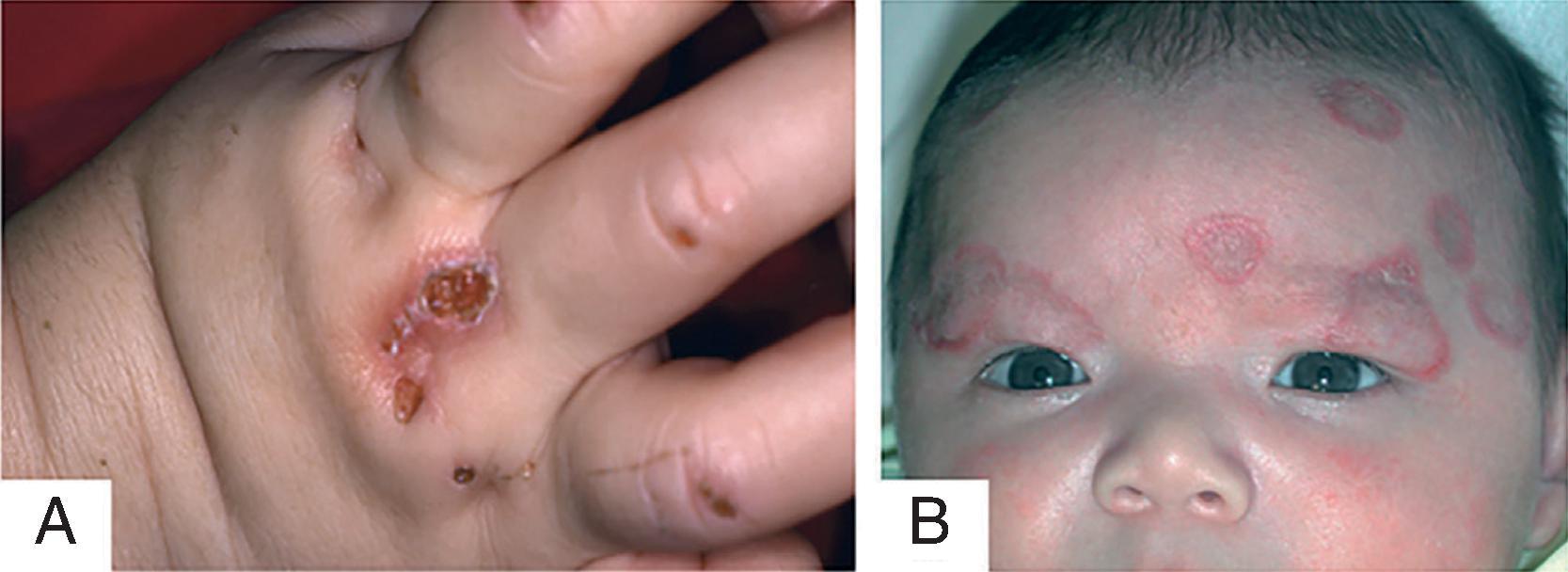
Benign pustular dermatoses include several innocent pustular eruptions that must be differentiated from infectious dermatoses. On biopsy, benign pustular dermatoses can be differentiated from herpes simplex lesions by the absence of multinucleated giant cells on Wright-stained smears of pustular contents. Negative Gram-stain and potassium hydroxide preparations can exclude bacterial and candidal infection. Viral and bacterial cultures may also help. Serologic studies for syphilis and scrapings for ectoparasites exclude syphilis and scabies in children with acropustulosis. Many benign pustular dermatoses can be confused with papulopustular rashes seen in sebaceous gland hyperplasia, miliaria, milia, and acne.
Erythema toxicum neonatorum is seen in up to 70% of full-term infants; the lesions, which are 2 to 3 mm in diameter, are erythematous and blotchy macules, papules, and pustules ( Fig. 102.6A ) that typically appear during the first 2 to 3 weeks after birth and then fade in about a week. A Wright stain of the pustule contents reveals sheets of eosinophils and occasional neutrophils; 15% to 20% of patients show circulating eosinophilia.
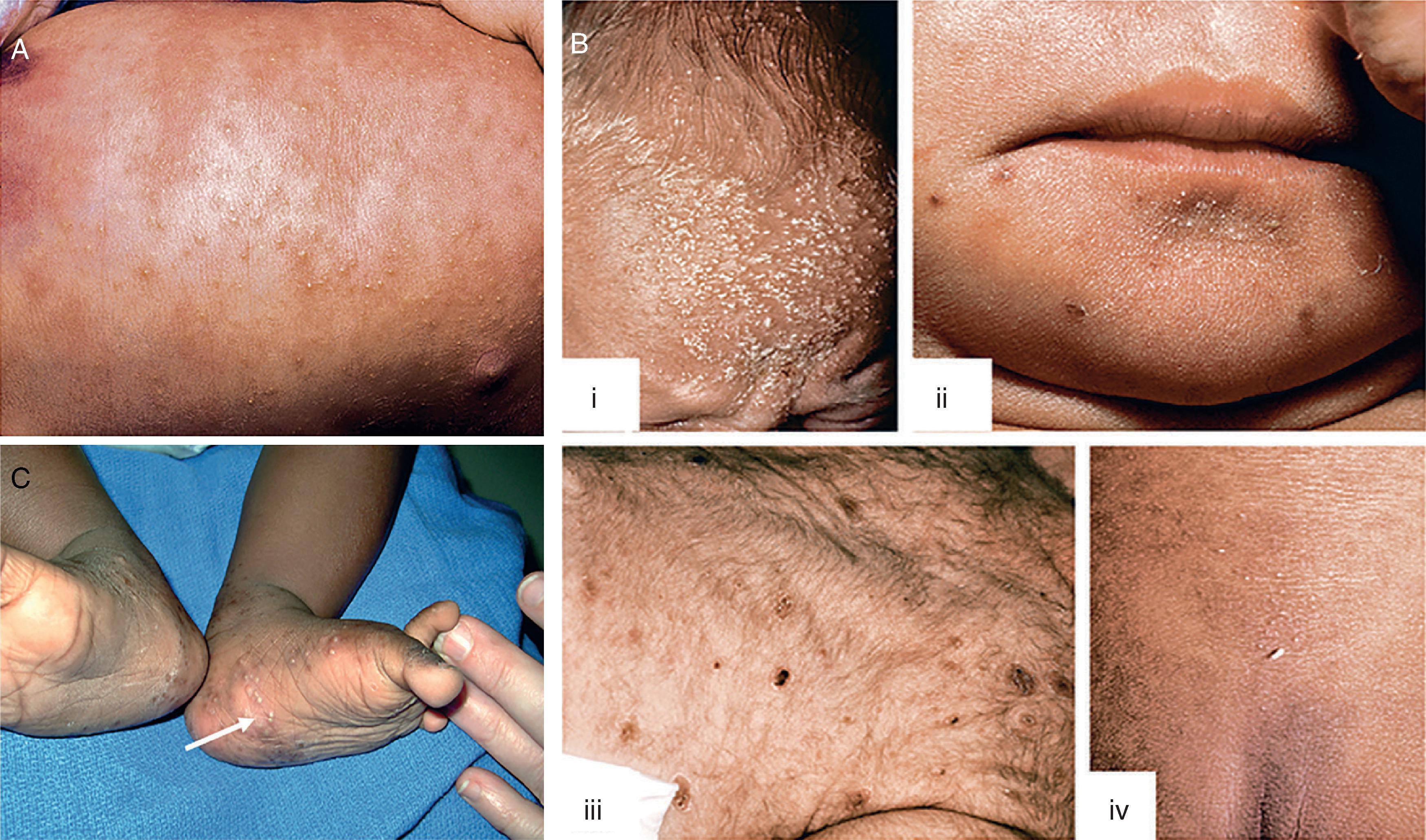
Transient neonatal pustular melanosis is seen in <5% of African American infants. Lesions may be seen at birth as pustules 2 to 5 mm in diameter on a nonerythematous base ( Fig. 102.6B ) on the chin, neck, upper chest, sacrum, abdomen, and thighs. A central crust appears in a few days, which then desquamates to leave a hyperpigmented macule with a collarette of fine scale. Often, only brown macules with a rim of scale may be seen at birth. In lightly pigmented newborns, little or no hyperpigmentation remains. A Wright stain shows neutrophils and rare eosinophils.
Acropustulosis of infancy is a chronic, recurrent, pustular, pruritic eruption that appears on the palms and soles ( Fig. 102.6C ) but may also involve the scalp, trunk, buttocks, and extremities. The lesions may first appear during the newborn period for 1 to 3 weeks, and episodes may recur until 2 to 3 years of age. The cause is unknown; some infants have had scabies infestations prior to the onset of these lesions. Histopathology shows sterile, intraepidermal pustules with neutrophils and occasional eosinophils. Oral dapsone (2 mg/kg/day) can suppress symptoms in 24 to 48 hours. Topical application of high-potency corticosteroids on the palms and soles can also help.
Eosinophilic pustular folliculitis (Ofuji disease) is a rare, self-limiting vesiculopustular eruption on the scalp and forehead characterized by recurrent, follicular white vesicles and pustules 2 to 3 mm in diameter on an erythematous base. The disease typically affects young children but has also been noted in a few neonates. The lesions are marked by intense pruritus. The lesions contain large numbers of eosinophils, but no microorganisms have been seen. In some cases, eosinophilic pustular folliculitis may precede a fully evident hyperimmunoglobulin E syndrome. Topical corticosteroids, oral erythromycin, dapsone, colchicine, indomethacin, and cyclosporine may be helpful.
Sebaceous gland hyperplasia is seen over the nose and cheeks of term infants. Lesions consist of multiple yellow papules 1 to 2 mm in diameter resulting from maternal or endogenous androgenic stimulation of sebaceous glands ( Fig. 102.7 ). The eruption resolves within 4 to 6 months.
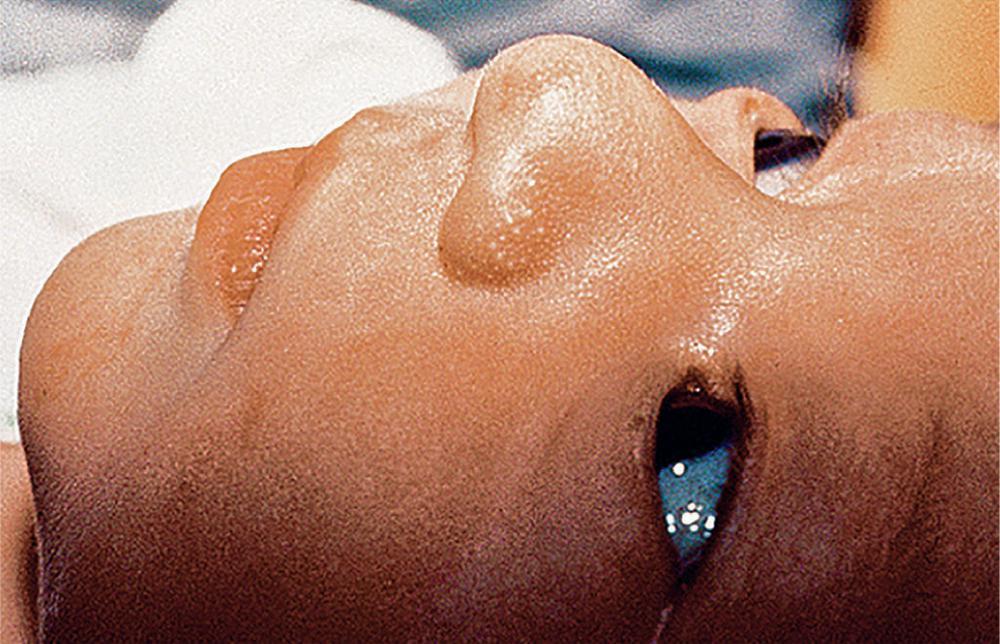
Milia lesions are pearly, yellow papules 1 to 3 mm in diameter on the face, chin, and forehead of about half of all newborns ( Fig. 102.8 ). Similar lesions can occasionally be seen on the trunk and extremities. Most lesions resolve during the first month without treatment. Histology shows miniature epidermal inclusion cysts arising from the pilosebaceous appendages of vellus hair.
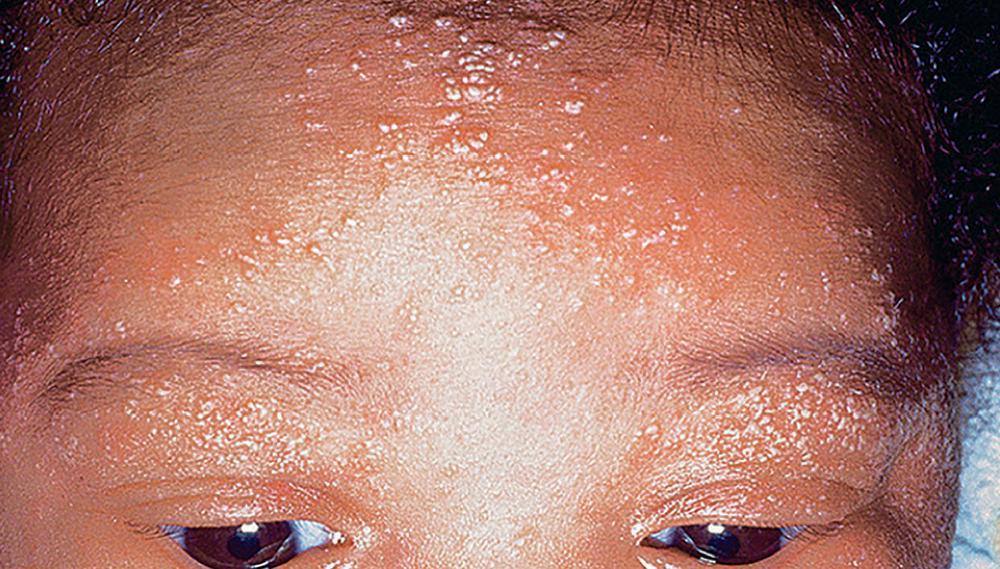
Miliaria results from obstruction and consequent rupture of eccrine sweat ducts. In term and preterm infants, miliaria occurs after the first week after birth in response to thermal stress. Lesions are seen in intertriginous areas and the scalp, face, and trunk. In miliaria crystallina , superficial vesicles 1 to 2 mm in diameter appear on noninflamed skin due to blockage of ducts in the stratum corneum ( Fig. 102.9A ). Small papules and pustules are typical of miliaria rubra (prickly heat), in which the obstruction occurs in the midepidermis ( Fig. 102.9B ). Deep-seated papulopustular lesions of miliaria profunda occur only rarely in infancy, when the duct ruptures at the dermal-epidermal junction. Cooling the skin and loosening clothing promotes resolution of the rash.
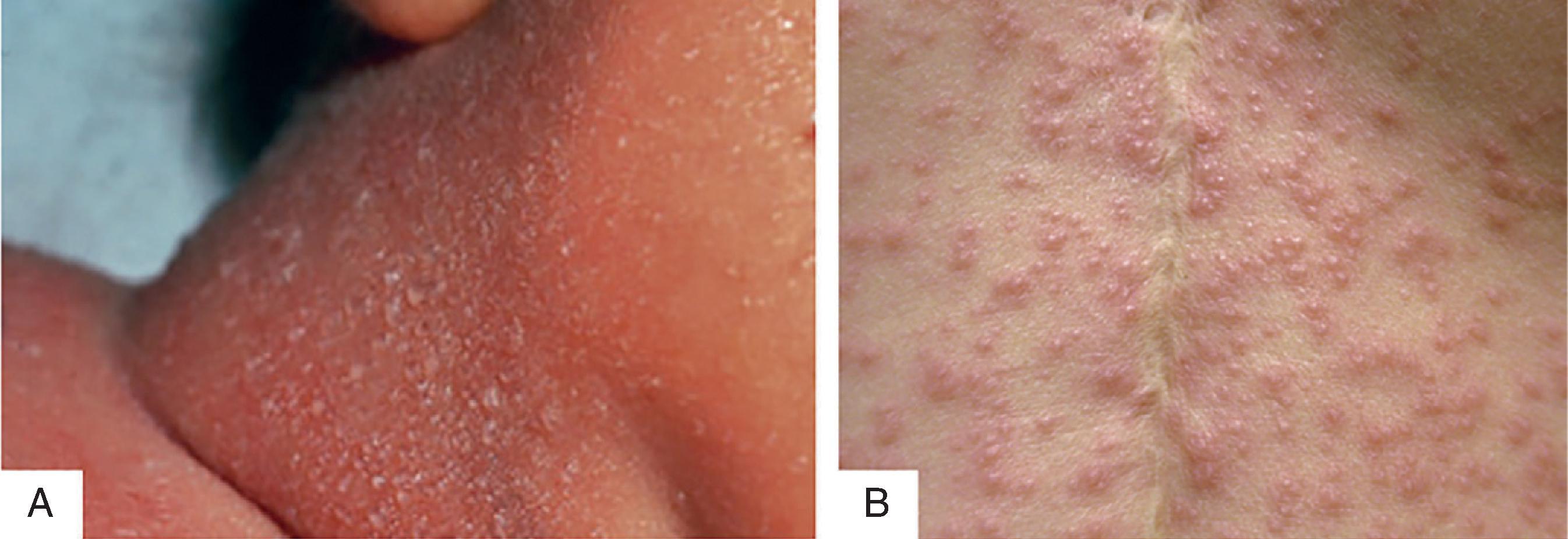
Neonatal acne occurs in up to 20% of newborns; lesions may be present at birth, but the average onset is at 3 weeks. Inflammatory red papules and pustules predominate, and cysts may be seen. Unlike adolescent acne, no comedones are seen ( Fig. 102.10 ). The etiopathogenesis was believed to be related to stimulation of sebaceous glands by maternal androgens, but recent evidence suggests that these lesions may be an inflammatory reaction to colonizing Malassezia species. Treatment is usually unnecessary because lesions involute spontaneously within 1 to 3 months. Ketoconazole cream may help in severe cases.
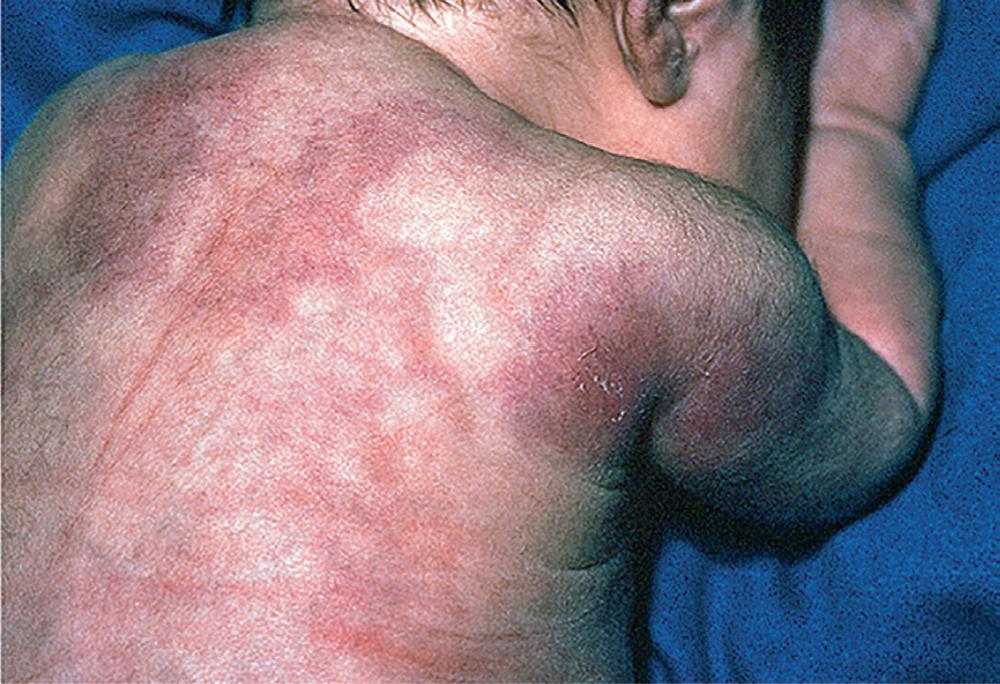
Subcutaneous fat necrosis is a rare, self-limited process that usually occurs in otherwise healthy full-term and postmature infants ( Fig. 102.11 ). It has been reported to occur after total body cooling for treatment of hypoxic-ischemic encephalopathy. Discrete, tender, firm, red or hemorrhagic nodules and plaques up to 3 cm diameter appear on the cheeks, back, buttocks, arms, and thighs during the first few weeks of life. The cause is unknown, but there may be a role of mechanical, cold, and hypoxic injury to fat. These nodules usually resolve without scarring in 1 to 2 months. Some lesions can get calcified. Many infants can develop nephrocalcinosis, poor weight gain, irritability, and seizures. Calcium should be monitored for the first 4 to 6 months after birth. In some infants, thrombocytopenia, hyperlipidemia, and hyperglycemia may occur. Histopathology demonstrates fat necrosis with a foreign-body, giant-cell reaction. Remaining fat cells contain needle-shaped clefts, and calcium deposits are scattered throughout the subcutis.
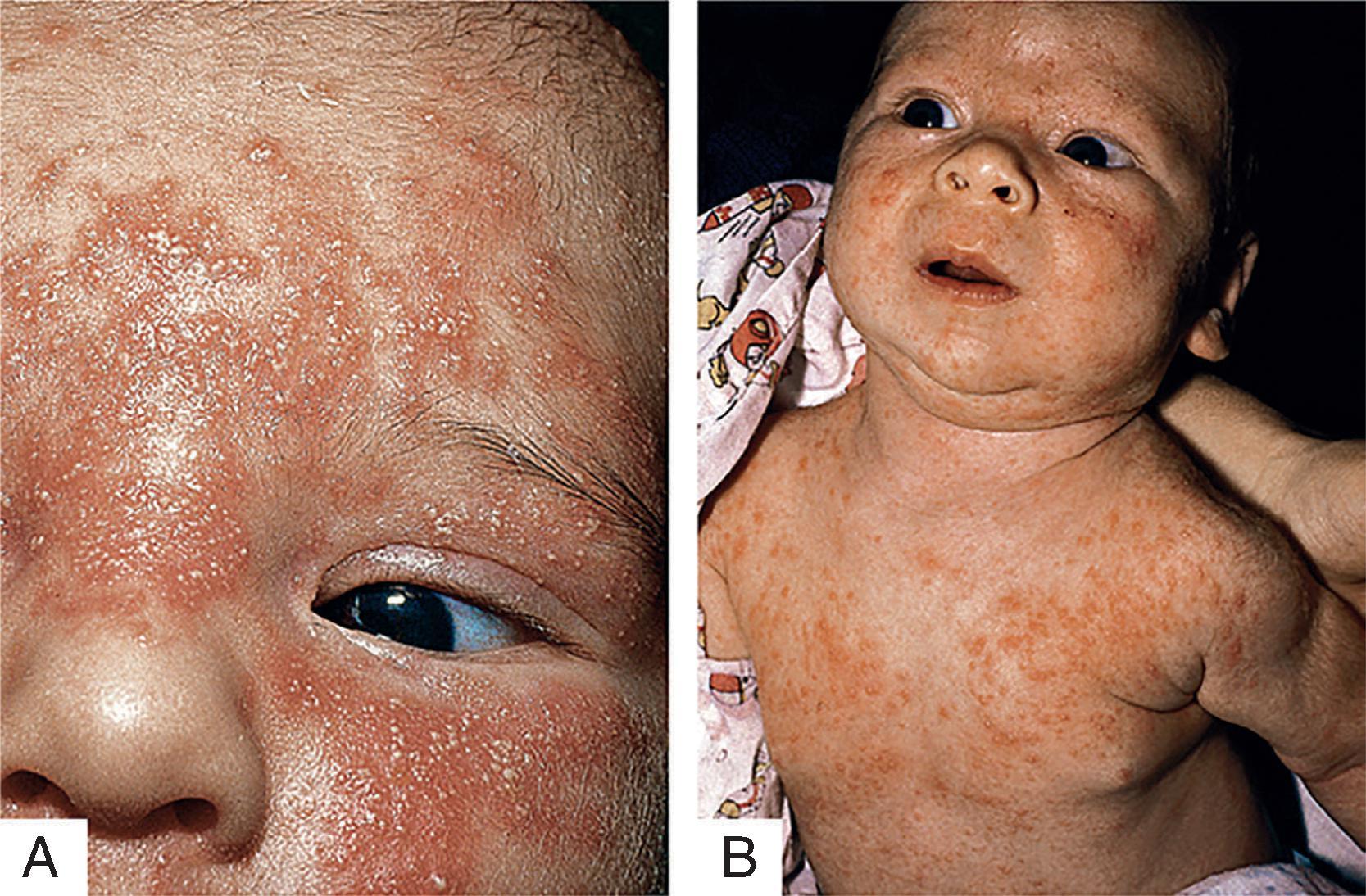
Neonatal lupus erythematosus occurs with annular erythematous plaques 0.5 to 3 cm in diameter on the scalp, face, neck, upper trunk, and upper extremities (see Fig. 102.5B ). A central scale, telangiectasias, atrophy, and pigmentary changes may be seen. Some affected infants may show hepatosplenomegaly, anemia, leukopenia, thrombocytopenia, and lymphadenopathy. The disorder has been associated with transplacentally acquired anti-SS-A (Ro) and anti-SS-B (La) antibodies. Topical corticosteroids can expedite the resolution of inflammation in skin lesions, although atrophy, telangiectasias, and pigmentary changes may persist. The use of sunscreens and avoidance of direct sun exposure for a few months can help.
Annular erythema of infancy is an innocent gyrate erythema with red papules/plaques. Lesions may show a dusky center and may exceed 10 cm in diameter over 1 to 3 weeks ( Fig. 102.12 ). This reaction may be triggered by infections and drugs. Fortunately, these infants generally continue to thrive, and most lesions eventually resolve without treatment.
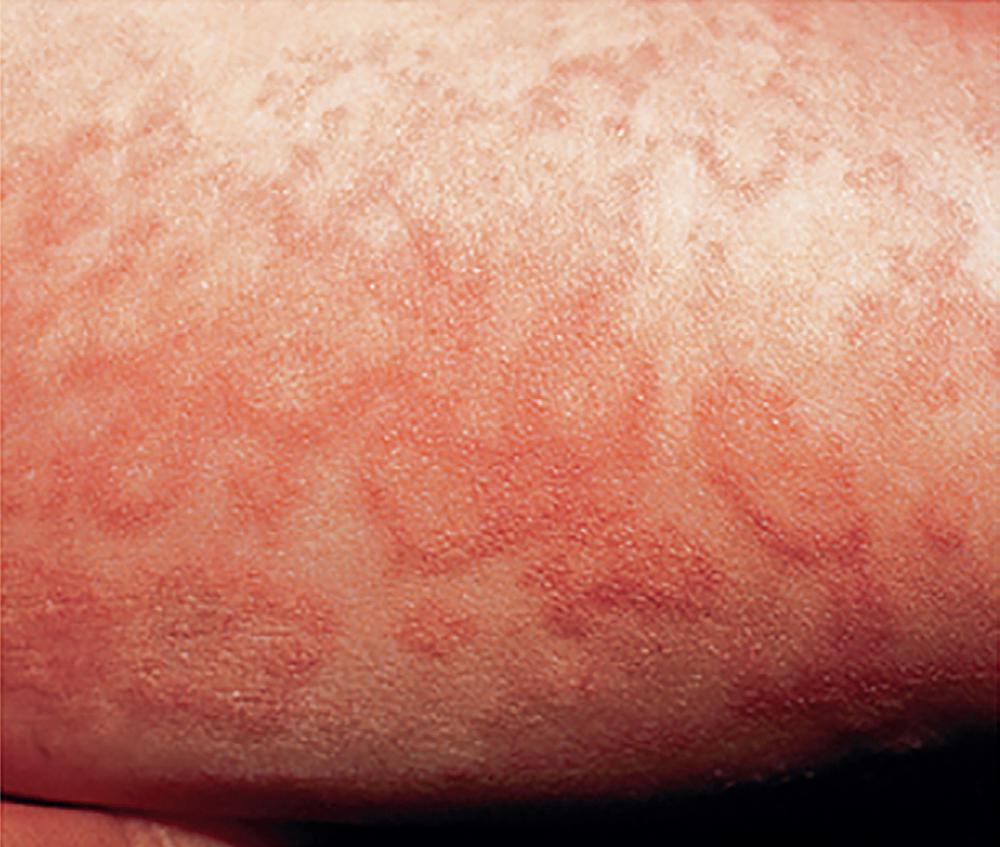
Dimpling is frequently seen over bony prominences, particularly in the sacral area ( Fig. 102.13A ). Skin dimples may be the first sign of several dysmorphic syndromes, but most such lesions are usually of only cosmetic consequence. Spinal anomalies should be excluded when deep dimples, sinus tracts, or other cutaneous lesions such as lipomas, hemangiomas, nevi, and tufts of hair are seen over the lumbosacral spine. This area is readily visualized by ultrasound during the first 8 to 12 weeks after conception. Magnetic resonance imaging may provide more details.

Periauricular sinuses, pits, tags/tragi, and cysts occur when brachial arches or clefts fail to fuse or close normally. These lesions develop between the preauricular area to the corner of the mouth ( Fig. 102.13B ). Defects may be unilateral or bilateral and are occasionally associated with other facial or more complex malformation syndromes such as Goldenhar (oculoauriculovertebral) syndrome or branchio-oto-renal syndrome. , Most lesions are excised during childhood.
Become a Clinical Tree membership for Full access and enjoy Unlimited articles
If you are a member. Log in here